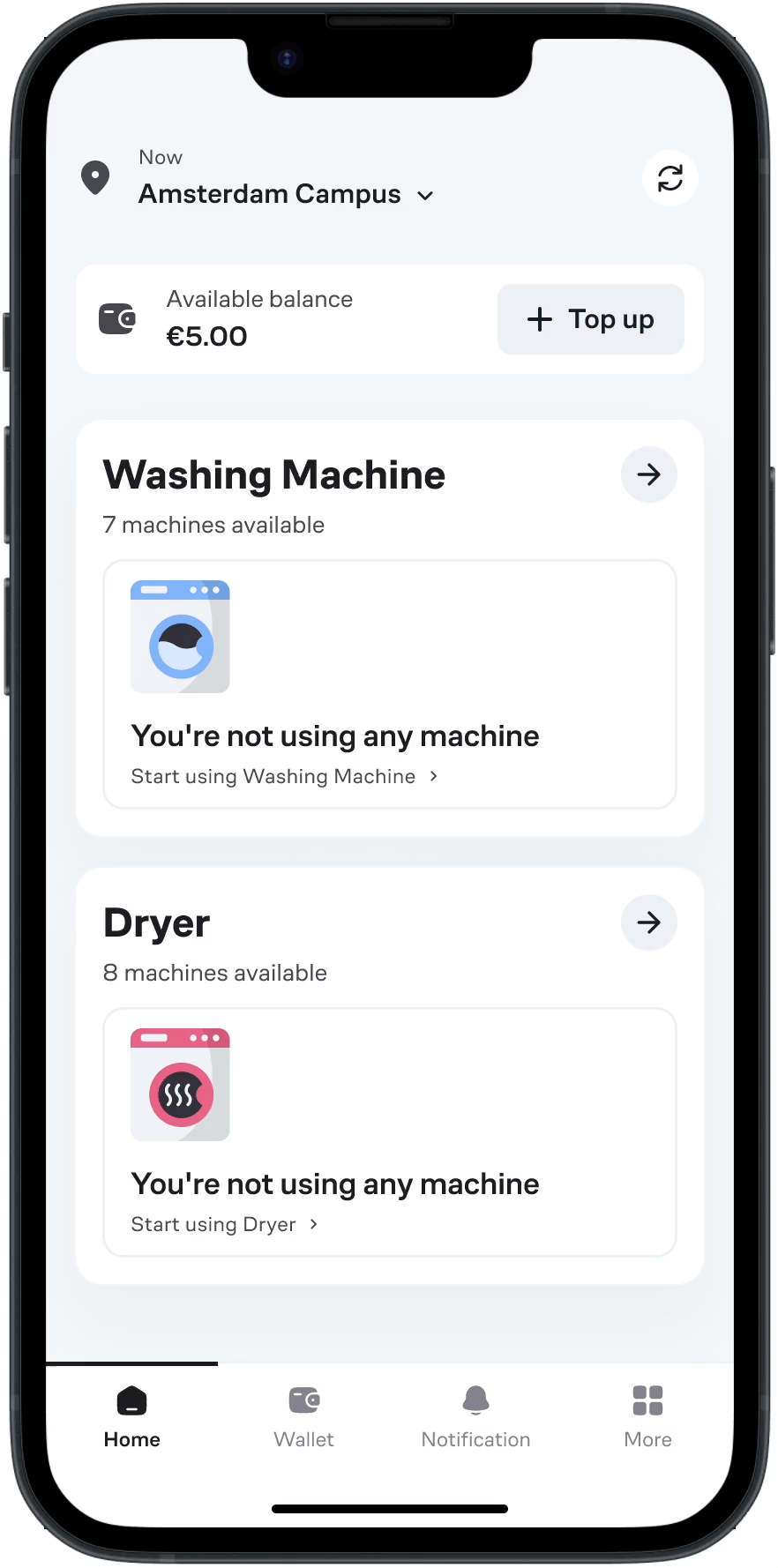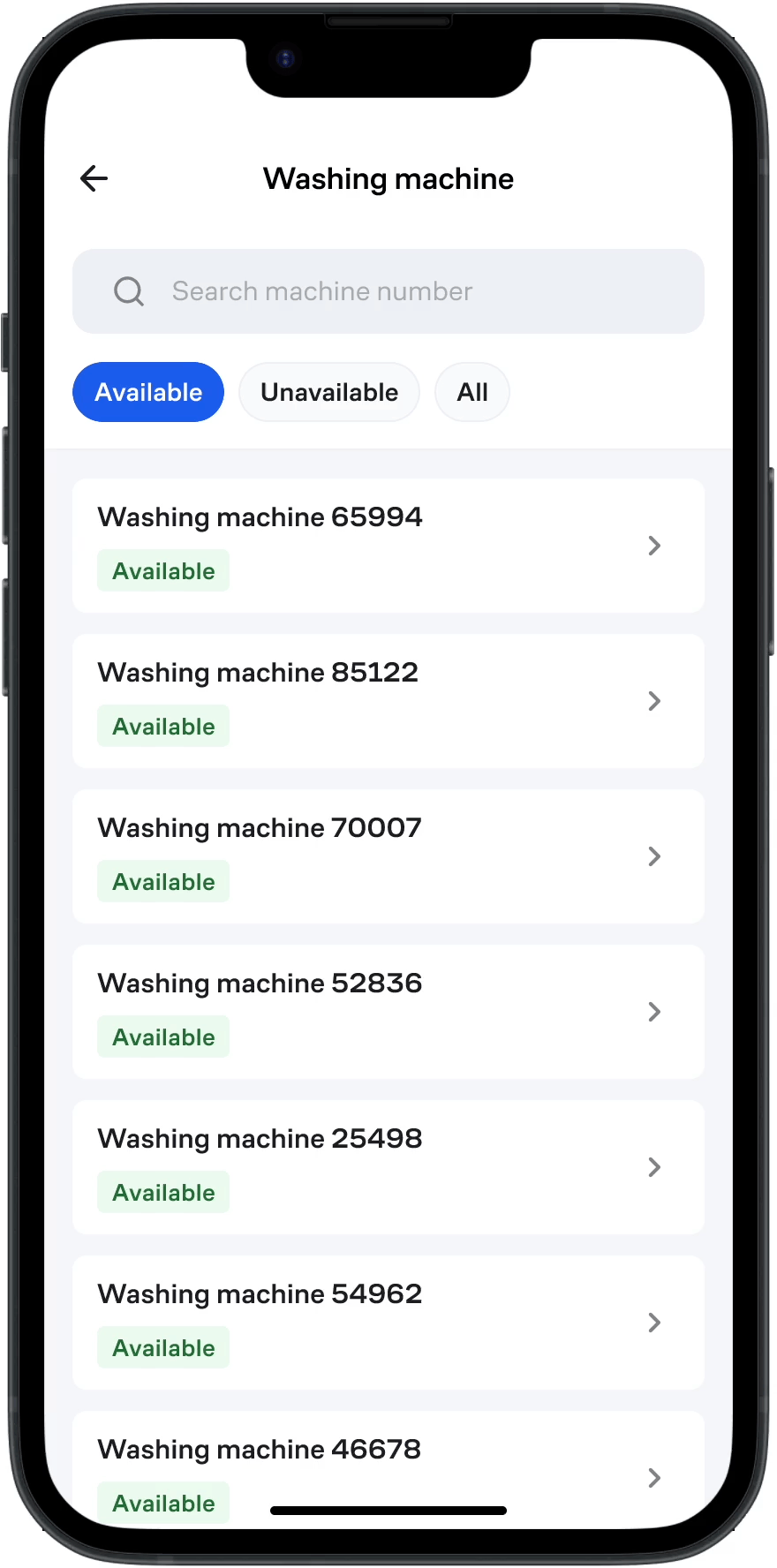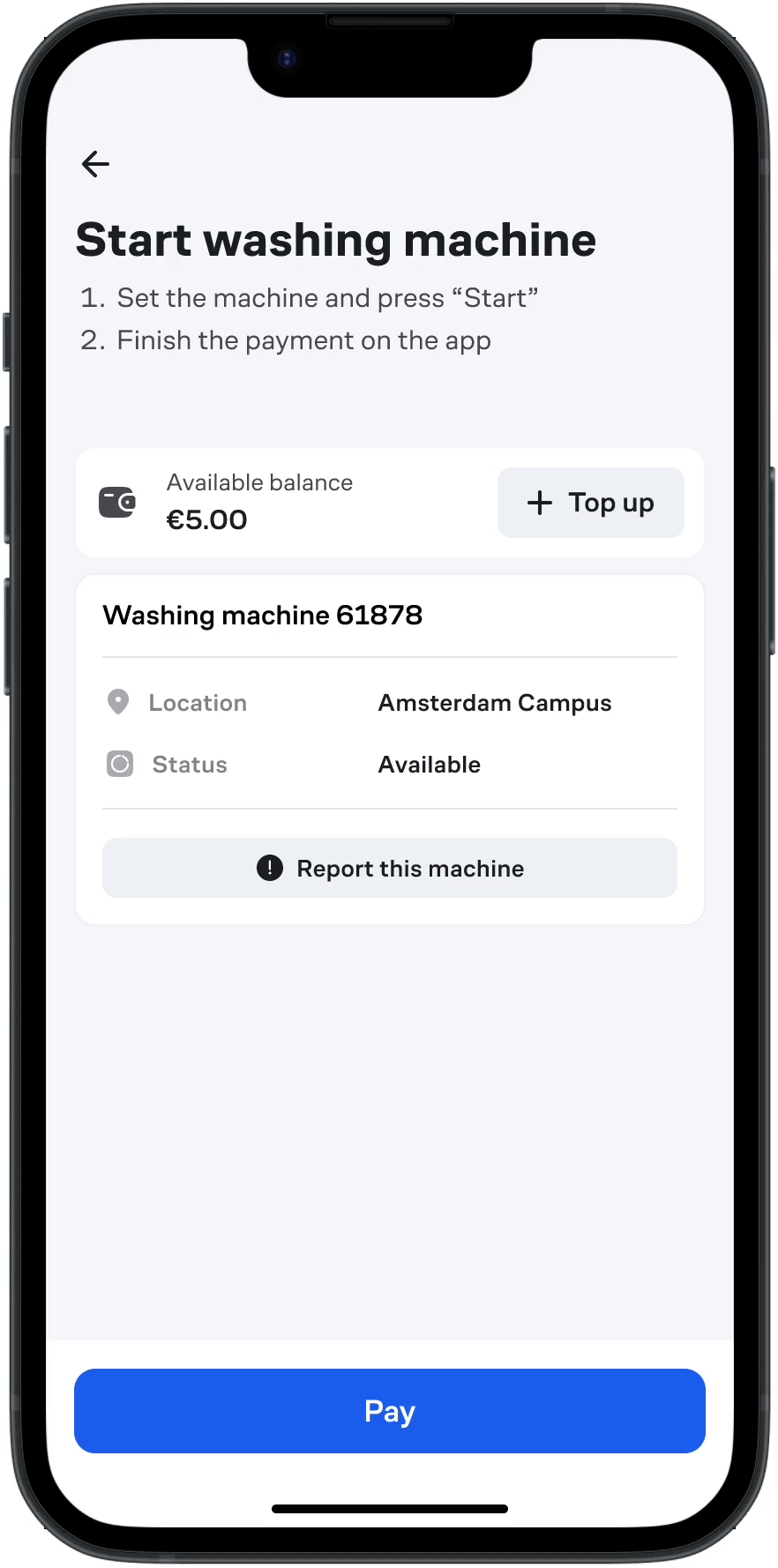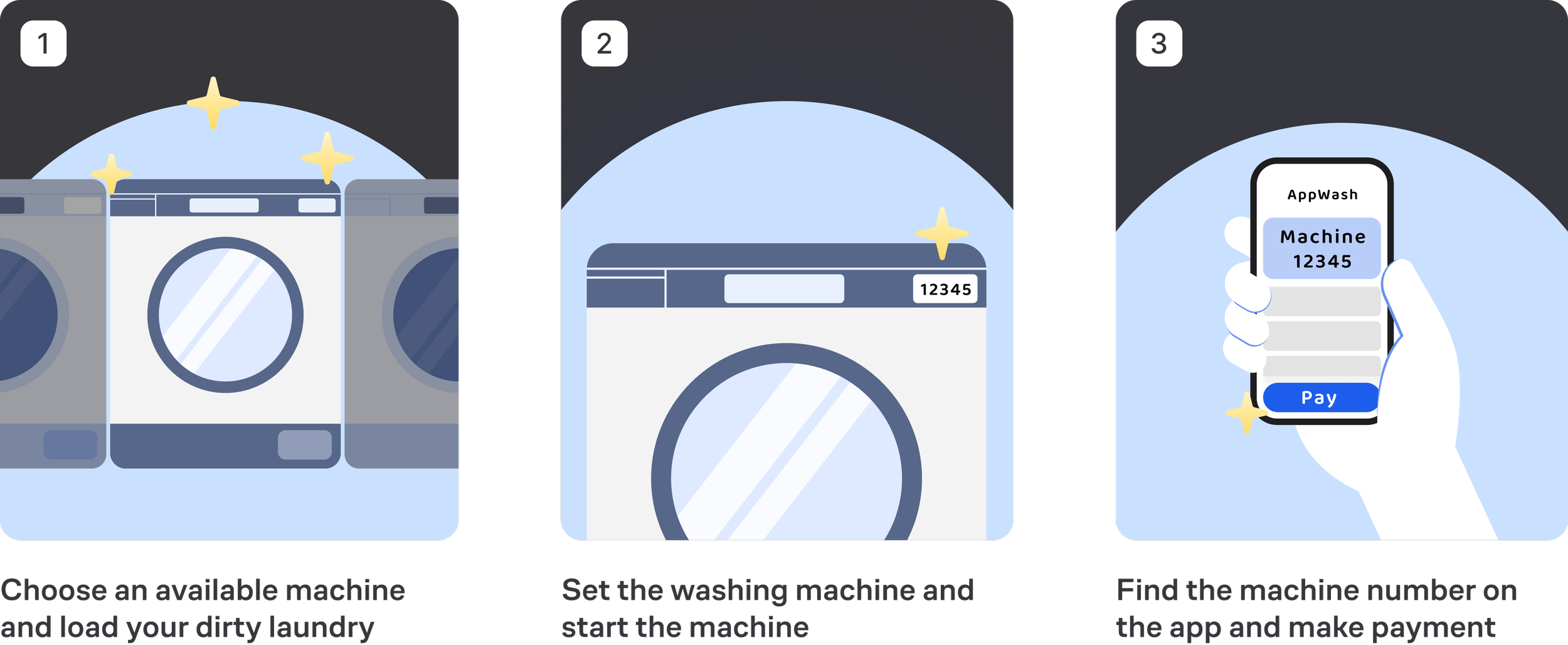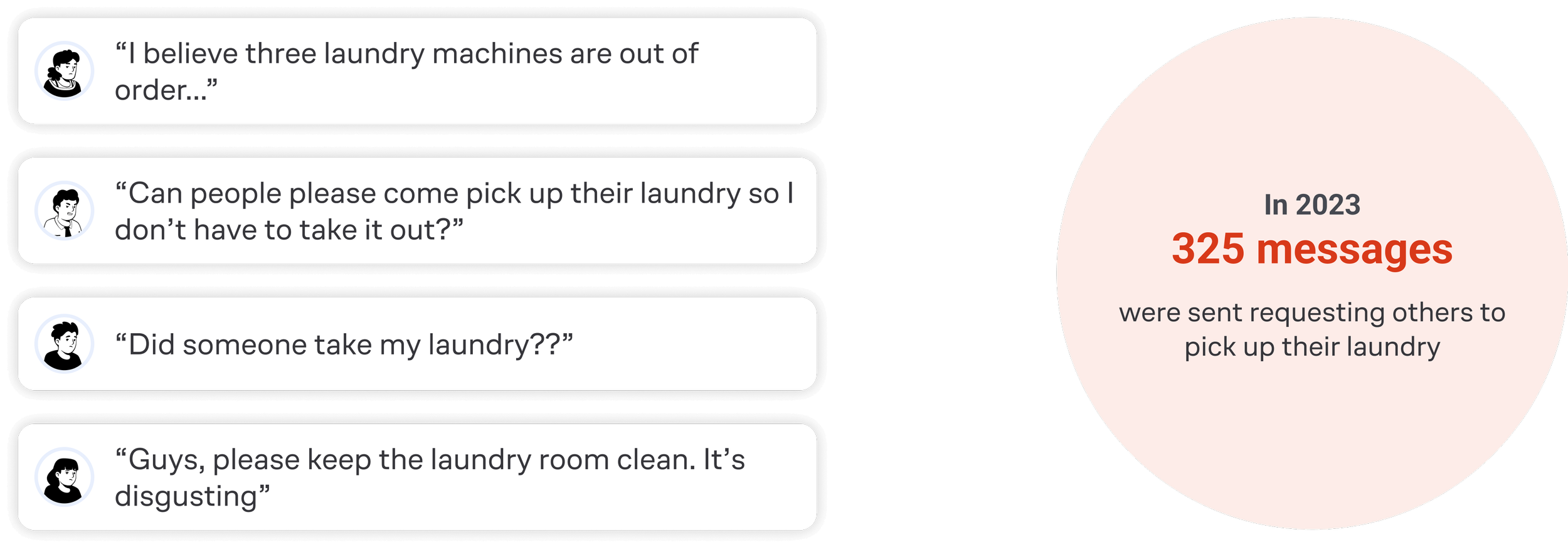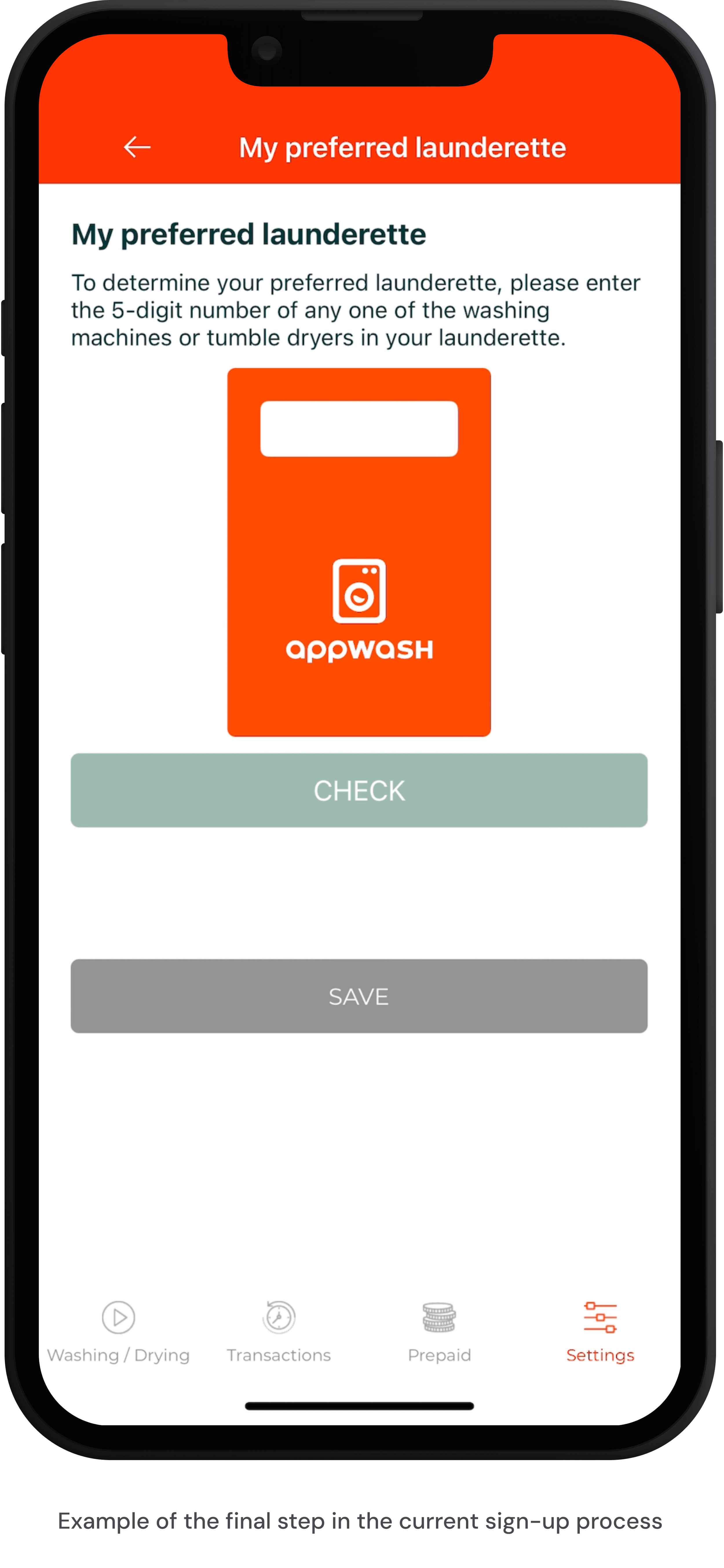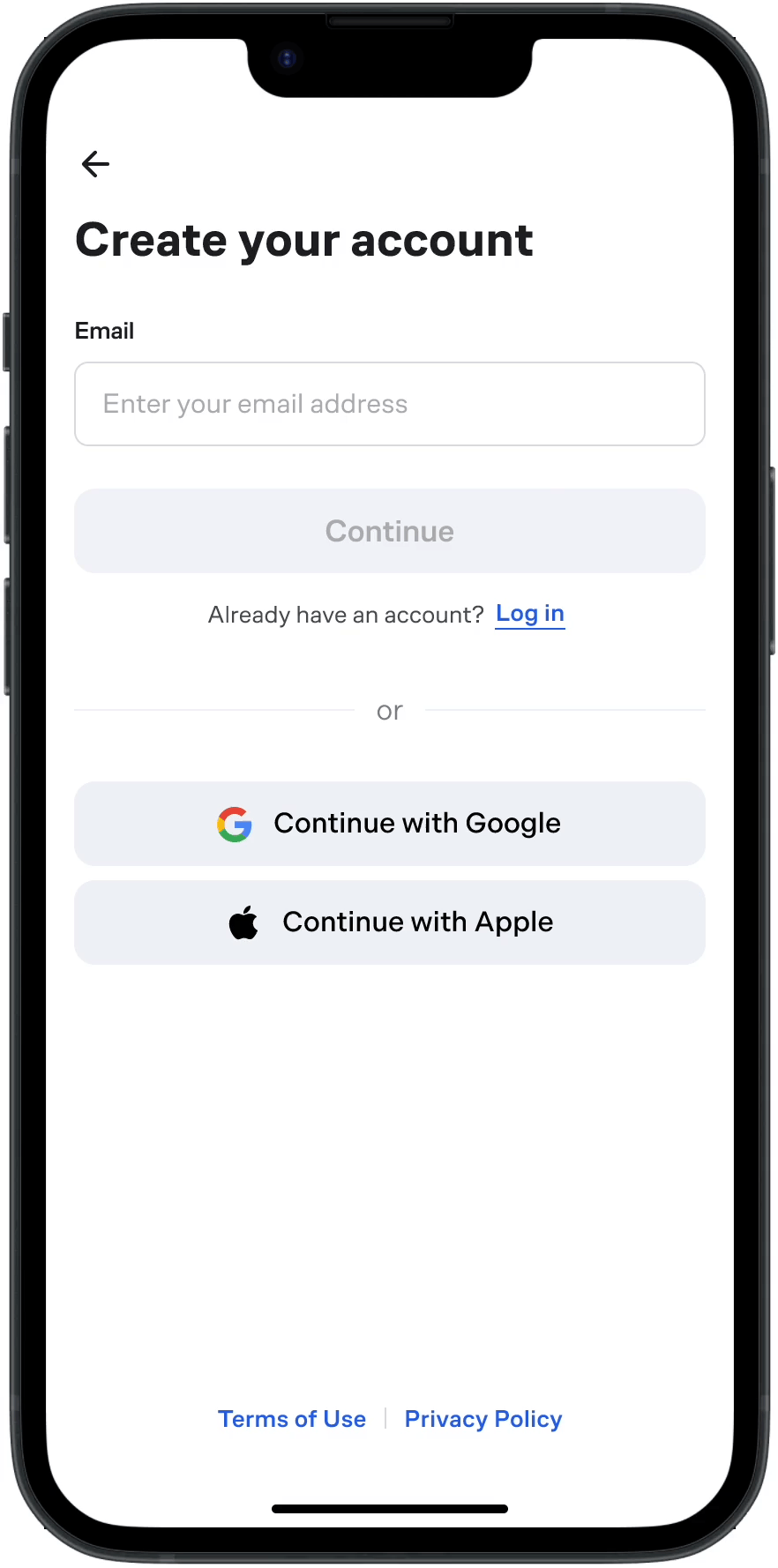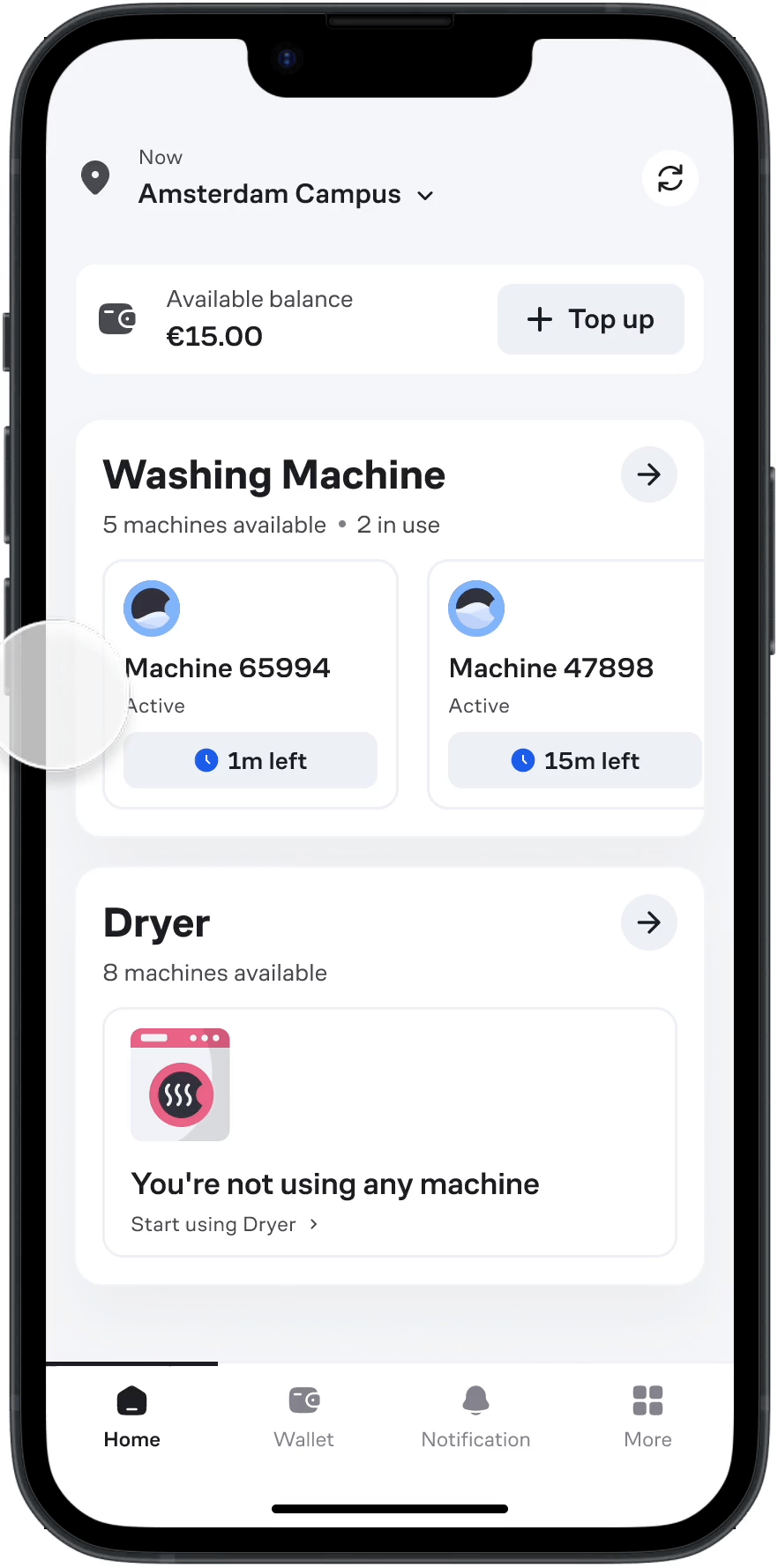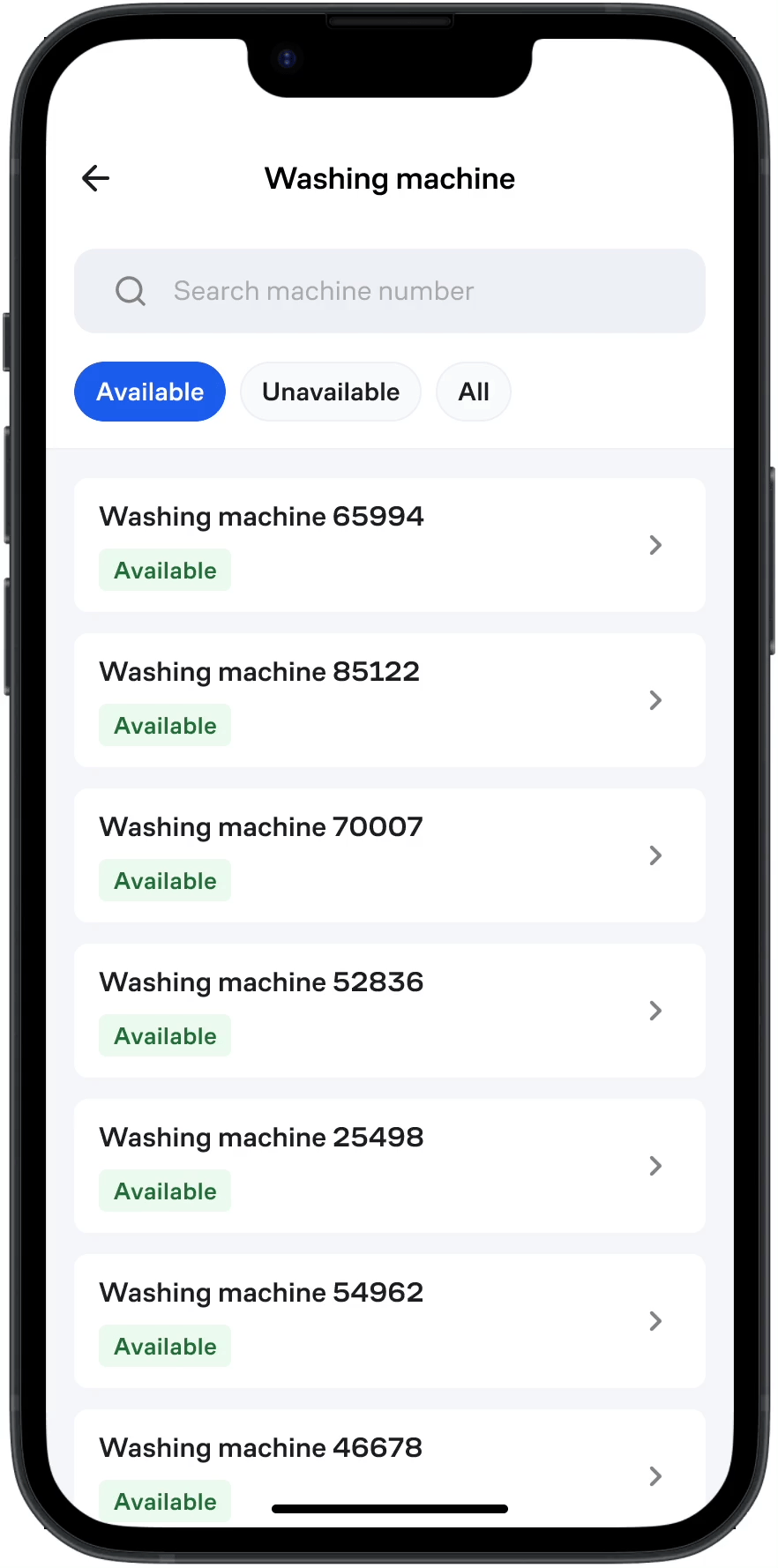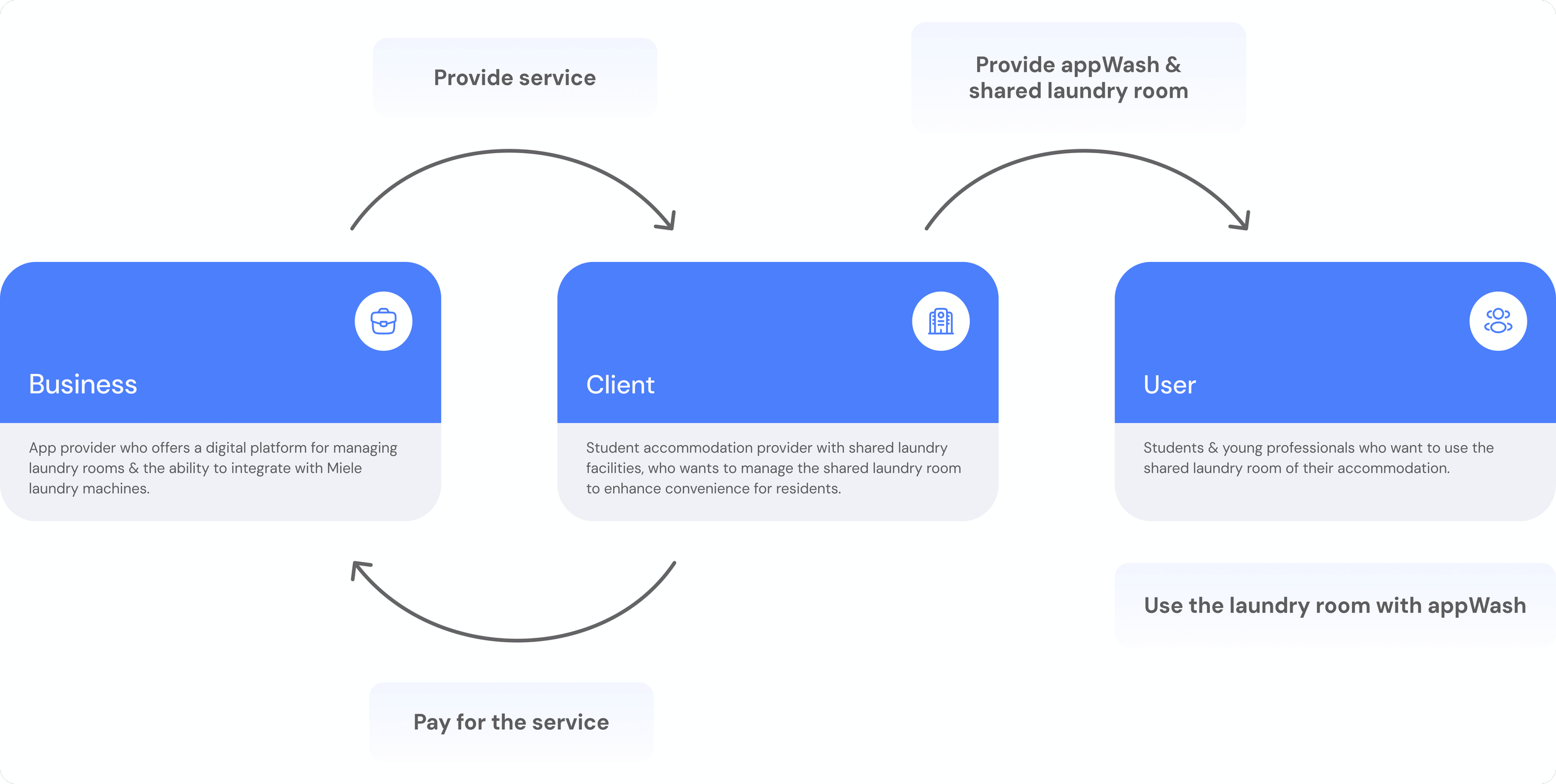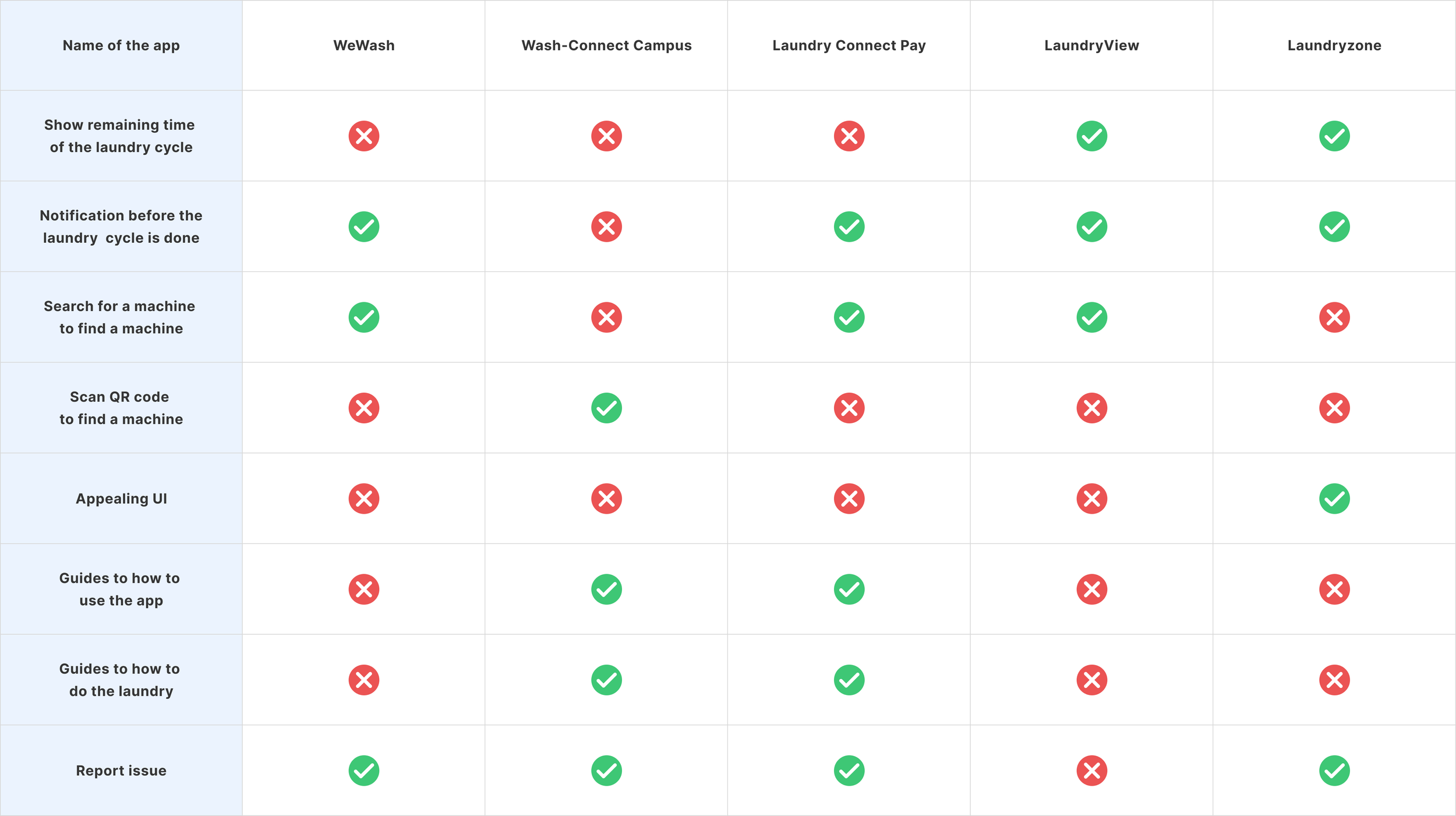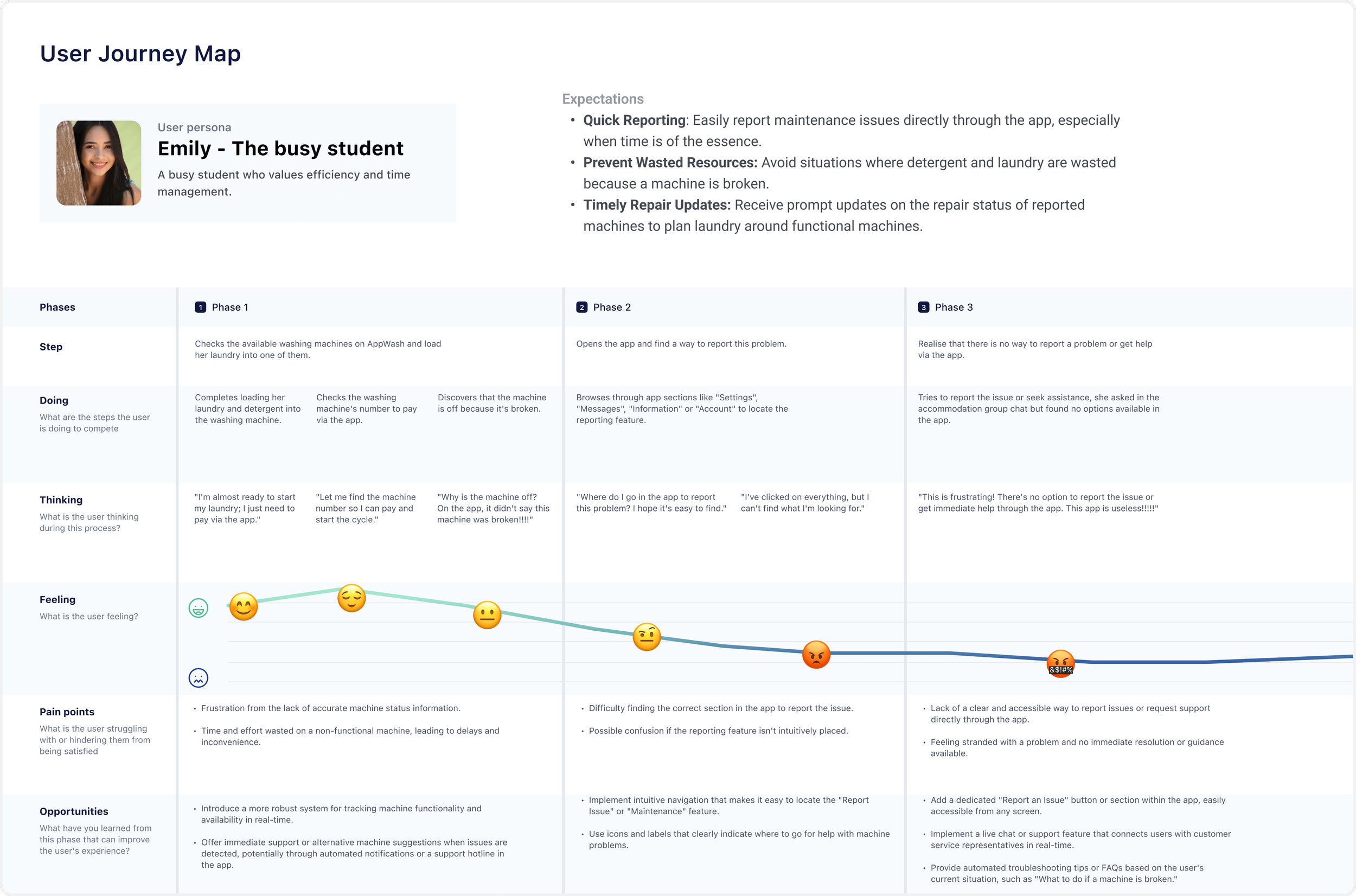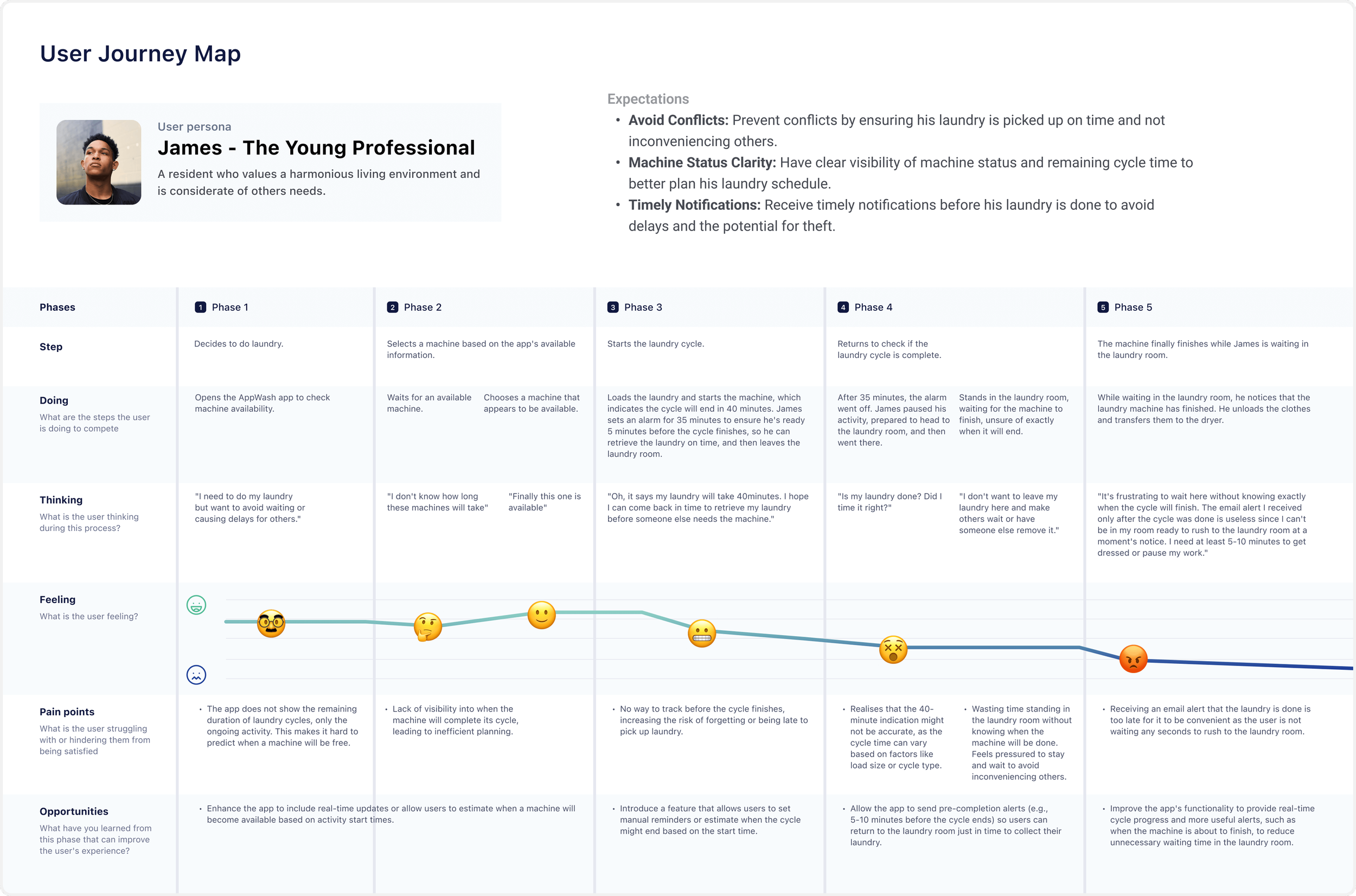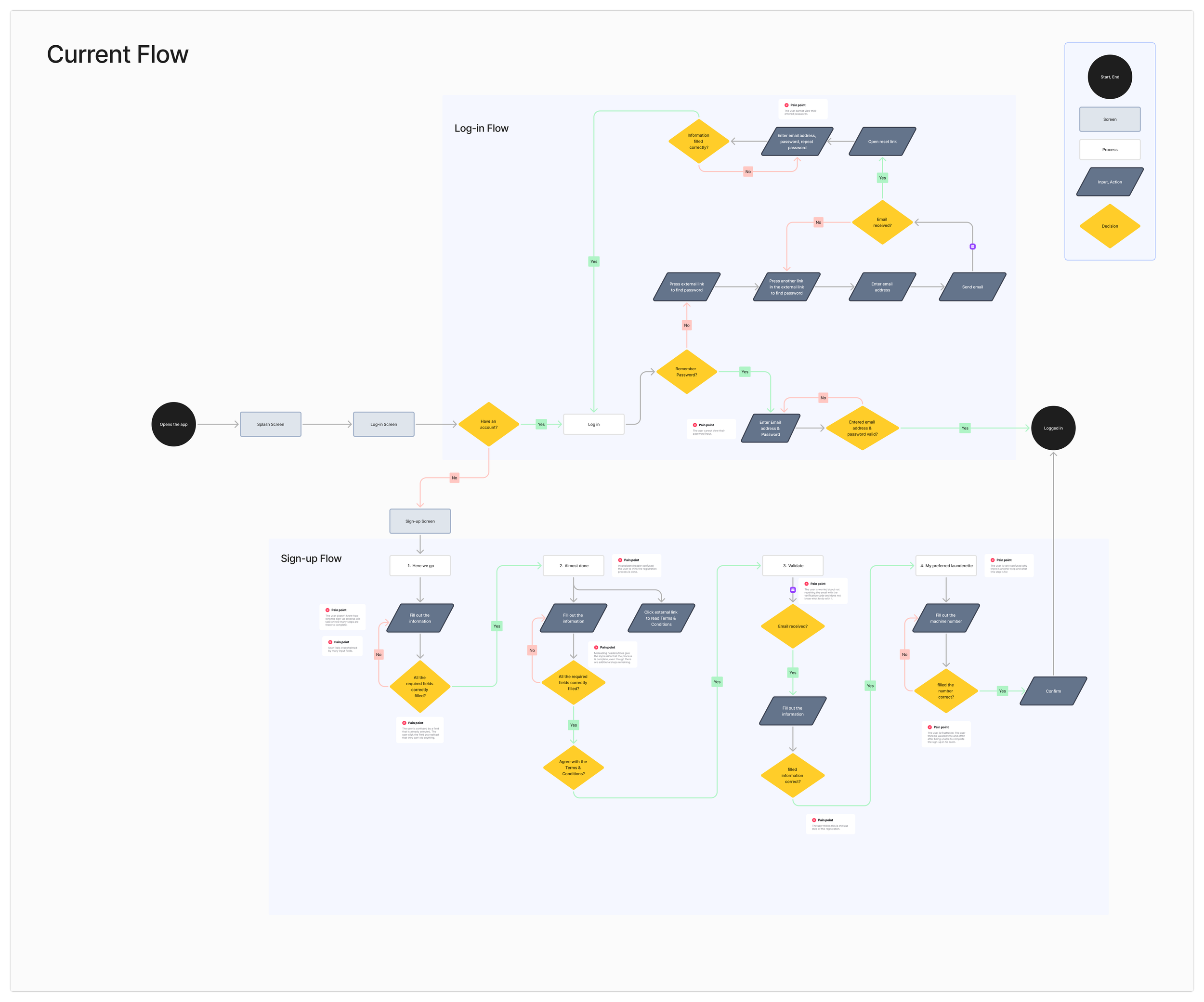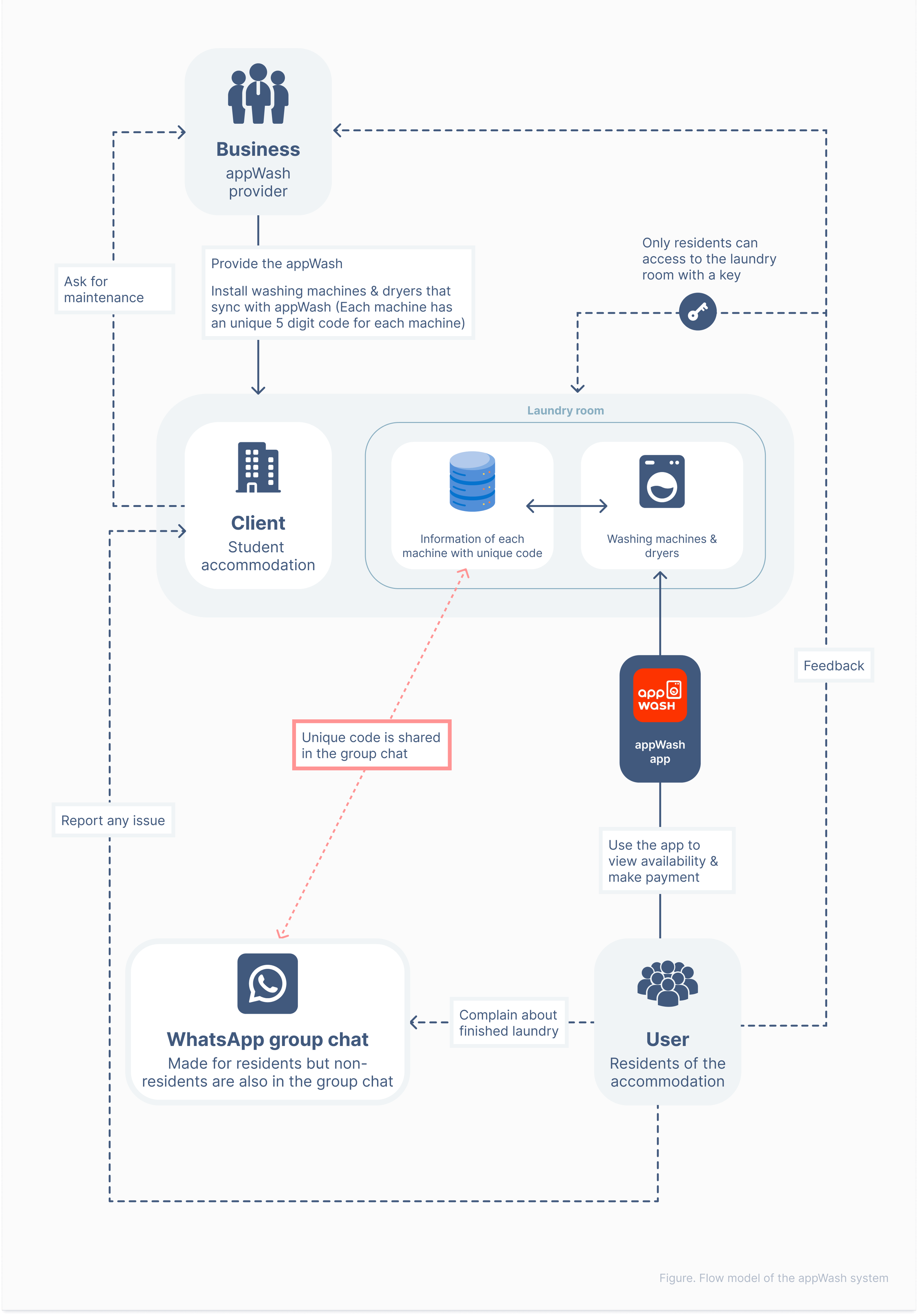
AppWash
I redesigned the AppWash app by identifying user pain points, creating wireframes and prototypes, and developing intuitive UI solutions to improve usability and the laundry experience.
Project Type
Solo Project
My Role
UI/UX Designer, Researcher
Tools
Figma, Photoshop, Interview
Timeline
2024 (4 weeks)
✨ Highlights: Smart solutions for smoother, stress-free shared laundry experiences.
The new AppWash design addresses users' most common frustrations in shared laundry spaces. From simplifying machine selection to streamlining issue reporting, these features make laundry day stress-free.
Clear System Overview
Instantly view available machines or the one you’re using on the home screen, making it easy to decide when to do laundry. If you’re using a machine, track its status in one glance.
Quick Machine Search
No more endless scrolling to find the machine you’ve loaded! The new search bar lets you locate your machine by number, saving time and reducing frustration when making a payment.
Easy Issue Reporting
Report broken machines in under 2 minutes directly through the app—no need to visit the security desk. Notifications are sent to the manager instantly, ensuring faster maintenance.

Introduction

THE APP
What is AppWash?
AppWash is a digital laundry management app that connects an entire laundry room for accommodation providers who need to ensure the optimal operation of the shared laundry room.

OUR USERS
Who is using the app?
The primary users are young, busy students. They’re busy with school, part-time jobs, and social lives, so they value tools that save time and reduce stress.

THE CHALLENGE
What are users experiencing?
While living at a student accommodation, I was introduced to AppWash. Every resident must download and sign up for the app to use the laundry room. As I used it for years, I noticed issues that made laundry days unnecessarily stressful.

THE BIGGER PICTURE
Why Laundry Efficiency Matters?
The shared laundry room has a limited space with a limited number of laundry machines that are shared by the entire residents. Efficiency wasn’t just a luxury—it was a necessity. Any delays, breakdowns, or misunderstandings disrupted the flow, leading to frustration for users and challenges for the accommodation provider.
Problems
PROBLEM 1
Inconvenient Sign-up process
The AppWash sign-up process requires users to complete four steps, with the final step requiring them to enter a 5-digit machine number displayed on each washing machine and dryer in the laundry room. This verification step ensures that only authorised residents can register.
Why can’t I make an account in my room?
Users often attempt to sign up from their rooms, expecting to complete the process before heading to the laundry room. This unexpected requirement forces users to abandon the process midway and restart it later.
Impact on Users (Pain Points)
User Frustration: The repetitive process wastes users’ time, leading to dissatisfaction.
Security Risks: Machine numbers are often shared in group chats, allowing unauthorised users to exploit the system.
PROBLEM 2
Inefficient notification system
AppWash notifies users through app push notifications and email once their laundry cycle is complete. However, these notifications don’t account for user behaviour, leading to delays in laundry collection.
Why Are People Not Collecting Their Laundry on Time?
Users often multitask, such as studying or working, while waiting for their laundry. When notified that the cycle is complete, they may not be able to immediately stop their activities and retrieve their laundry.
Also, users forget to collect their laundry, and those who want to use the machine need to wait for the finished laundry to be removed or forced to remove a stranger’s laundry onto the communal table in the laundry room.
Impact on Users (Pain Points)
Delays and Conflicts: Machines remain occupied even though they appear available on the app, leading to user frustration and complaints.
Theft and Misplacement: Uncollected laundry is often removed by others and placed on the communal table, risking theft, damage, or dirt.
PROBLEM 3
Difficulty in Machine Selection for Payment
After loading a machine, users must find its corresponding 5-digit code in the app to make payment. The machine list is randomly ordered, making this process unnecessarily time-consuming.
I don’t want to be bothered going to the security desk…
Users often end up not reporting the issue by ignoring it or just mentioning it in the group chat, which leads to a delayed maintenance system.
Impact on Users (Pain Points)
Delayed Maintenance: Unreported issues lead to prolonged machine downtime, reducing the availability of functioning machines.
Overcrowding: Fewer operational machines increase waiting times and cause overcrowding in the laundry room.
Solutions
SOLUTION 1
Convenient Sign-Up with Remote Verification
Separate accommodation verification from the sign-up process. Users can complete registration remotely and verify accommodation details later when accessing the laundry room.
Why This Works
Users tend to create an account in their rooms before heading to the laundry room.
Impact
Higher Sign-Up Completion Rate: Users can complete the sign-up process without any barrier.
SOLUTION 2
Smart Notifications
Introduce routine-based reminders with early warnings and backup notifications to align with user behaviour. Add a confirmation feature to reinforce task completion.
Primary Notifications: Early reminders (10–15 minutes before cycle ends).
Backup Notifications: Follow-up alerts if laundry isn’t collected promptly.
Backup Notifications: Follow-up alerts if laundry isn’t collected promptly.
Completion Confirmation: Users confirm task completion in the app.
Why This Works
This approach reduces delays by aligning notifications with user routines, a concept supported by research (Stawarz et al., 2014). Backup reminders mitigate forgetfulness, while confirmation prompts help build habits over time.
Impact
Increased timely collection: Stawarz et al. (2014) highlight that routine-based reminders are more effective, so we can assume that users are more likely to collect their laundry on time.
SOLUTION 3
Easy Machine Search and Sorting
Introduce a search function and sorting features to streamline the process of selecting the correct machine.
Search Bar: Allows users to type the machine number and locate it instantly.
Sorting by Status: Machines are grouped into categories such as “Available,” “Unavailable” and “Out of Order.”
Why This Works
This solution reduces cognitive load and streamlines navigation, enabling users to complete payments more efficiently while minimising errors.
Impact
Significant Search Time Reduction: The task completion time was reduced by approximately 58%.
SOLUTION 4
In-App Reporting System
Enable users to report machine issues directly through the app, ensuring faster maintenance and improved system reliability.
Why This Works
An in-app reporting system encourages users to report issues promptly, reducing downtime for machines and enhancing overall laundry room efficiency.
Impact
90% of users will use the in-app reporting feature at least once during their stay.
Process
Research
DOMAIN RESEARCH
Understanding the laundry management domain
In communal living spaces, such as student accommodations and multi-housing complexes, shared laundry rooms must be managed to maximise efficiency and user satisfaction. Key operations include ensuring machine availability, proper functionality, and easy access to services.
COMPETITOR ANALYSIS
Identify feature gaps and opportunities for differentiation
A comparison of AppWash with its competitors revealed that AppWash lacks several key features commonly offered by others. However, most competitors also fail to address certain critical user needs. This presents a market gap that AppWash can leverage by addressing these unmet needs, enabling it to resolve key user pain points while positioning itself for broader global expansion.
DATA SOURCES
Personal Observation
As a long-term user of AppWash, I was the primary source of insights. I documented my experiences with the app, noting recurring frustrations and usability challenges.
Resident Complaints
By closely interacting with other residents in the group chat, I identified three common complaints that aligned with my observations:
Delayed Laundry Collection: Users often fail to pick up their finished laundry on time.
Laundry Theft: Clothes left unattended are sometimes stolen or misplaced.
Poor Maintenance: Issues such as flooded floors due to broken machines or non-functional machines falsely displayed as available on the app.
User Interviews
I interviewed five residents to gain deeper insights into their laundry experiences. These conversations revealed consistent pain points and validated the complaints I had identified.
Current Interface
Lastly, I gathered screenshots of the current AppWash interface and organised them into user flows. By analysing these flows, I uncovered several critical design issues:
Inconsistency: Lack of uniformity in interface elements and interactions.
Poor Error Prevention: Limited safeguards against user errors or system failures.
Inefficiency: Redundant steps and cumbersome processes that hinder usability.
Data analysis & Modelling
DATA ELICITATION
Organising all the insights gathered from the data sources
I extracted work activity notes from the three data sources, which I grouped, organised, and sorted. Identifying patterns allowed me to categorise the data into three key areas: (a) user persona, stories and requirements, (b) inputs for data models, and (c) affinity diagrams for deeper analysis.
USER PERSONA, USER SCENARIO & USER JOURNEY MAP
Understanding our users
I developed user personas and journey maps to gain insight into who the users are, what they need, how they interact with the app, and where improvements can be made to enhance their experience.
USER FLOW
How do users interact with the app?
I developed flow models that illustrate how users interact with the app. I aligned each archetype with its corresponding user journey, along with their respective success metrics.
FLOW MODEL
How does information & artefacts flow through the system?
I then identified the basic system flow to gain an overview of how information, artefacts, and work products move between user roles and different parts of the system as a result of user interactions.
Define
IDENTIFYING THE PROBLEMS
So what are the problems?
In the Usage Research & Data Analysis, I could identify 4 main problems that showed the most often.
Inconvenient Sign-up process
Inefficient notification system
Difficulty in Machine Selection for Payment
No reporting option
What if those problems are not solved?
Those problems need to be solved because they have significant impacts on all the main stakeholders.
For Users (Residents, who use the app)
Increased Frustration and Stress: Unresolved inefficiencies negatively impact their overall satisfaction and create unnecessary stress in their daily routines.
Loss of Trust in the System: Persistent issues lead users to view the app as unreliable. This diminishes trust in both the app and the shared laundry experience, discouraging them from using it effectively.
Disruptions in Daily Activities: Delays caused by uncollected laundry, non-functional machines, or inefficient workflows force users to spend more time managing laundry tasks, disrupting their schedules and reducing their overall quality of life.
For Accommodation Providers (Clients, who are using the service)
Increased Complaints: Tenant dissatisfaction with delays and inefficiencies leads to more complaints towards property managers.
Operational Inefficiencies: Cluttered laundry rooms and uncollected laundry disrupt communal spaces, reflecting poorly on management.
Reputational damage: Persistent tenant frustrations may damage the property’s reputation and tenant retention.
For Miele (Business, who provides the service & app)
Reduced User Trust: App inefficiencies harm the user experience, leading to lower adoption and retention rates.
Weakened Client Relationships: Dissatisfied accommodation providers may switch to competitors, risking a loss of contracts.
Missed Competitive Opportunities: Failure to address these pain points limits Miele’s ability to differentiate itself in the market.
Opportunity for Improvement
By solving these problems, AppWash can deliver a seamless, user-friendly experience that satisfies tenants, improves property management operations, and strengthens Miele’s market position.
Articulate
IDEATE
Sketch & Wireframe & Design
I sketched out all the flows and ideas in my mind. The goal at this stage was to brainstorm and organise the design concepts generated in the earlier steps. Then I created medium-fidelity wireframes on Figma to visualise the structure and layout of my redesigned app. The purpose was to show how key features and interactions will be organised.
Conclusion
The AppWash Redesign project was an exciting opportunity to tackle real problems and improve both my skills and design process. It allowed me to use my experience with the app and new knowledge to create meaningful solutions. Although the redesign process took about three weeks, I also took time to explore, learn, and grow as a designer. Thanks to the time management skills I learned during my internship at DTT, I could stay organised and track my time, even with the extra pauses for learning.

